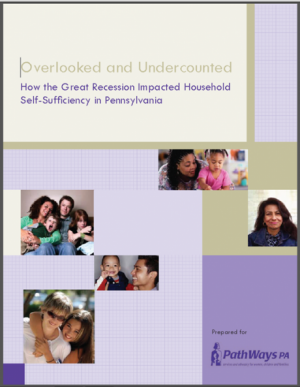Self-Sufficiency Standard for PA (2012)
PathwaysPA, in collaboration with The Center for Women’s Welfare, biennially publishes the Self-Sufficiency Standard for Pennsylvania.
The Self-Sufficiency Standard defines the amount of money needed for various family compositions (single parent of one child, two parents with two children, etc.) to meet their basic needs without public or private assistance.
The Self-Sufficiency Standard differs from the federal poverty level (FPL) in several important ways. Created in the 1950s, FPL was based on the USDA’s food budgets that meet minimum nutritional standards. Since inception, FPL is only updated with inflation.
By contract, the Self-Sufficiency Standard:
- Includes all major expenses families face including housing, food, child care, transportation, health care, taxes and miscellaneous costs;
- Calculates rates based on local or regional data to better reflect that actual costs associated with those needs; and
- Varies by the age of children, among other differences.
This most recent report – Overlooked and Undercounted: How the Great Recession Impacted Household Self-Sufficiency in Pennsylvania – combines the Self-Sufficiency Standard with another signature report series of PathwaysPA, Overlooked and Undercounted. Pathways and The Center used the Self-Sufficiency Standard as the yardstick by which to measure the impact of the Great Recession on Pennsylvanian families struggling to make ends meet.
Download the report at the link below.
